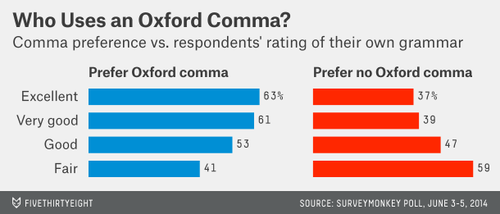Sandbox: Difference between revisions
(uote>) |
|||
| Line 2: | Line 2: | ||
[http://fivethirtyeight.com/datalab/elitist-superfluous-or-popular-we-polled-americans-on-the-oxford-comma/ Elitist, superfluous, Or popular? We polled Americans on the Oxford comma]<br> | [http://fivethirtyeight.com/datalab/elitist-superfluous-or-popular-we-polled-americans-on-the-oxford-comma/ Elitist, superfluous, Or popular? We polled Americans on the Oxford comma]<br> | ||
By Walt Hickey, ''FiveThirtyEight'', 17June 2014 | By Walt Hickey, ''FiveThirtyEight'', 17June 2014 | ||
The following quote from the article illustrates the issue: | |||
<blockquote> | |||
We asked respondents which sentence was, in their opinion, more grammatically correct: “It’s important for a person to be honest, kind and loyal.” Or: “It’s important for a person to be honest, kind, and loyal.” The latter has an Oxford comma, the former none. | |||
</blockquote> | |||
<center>[[File:Hickey-OxfordComma.png | 500px]]</center> | <center>[[File:Hickey-OxfordComma.png | 500px]]</center> | ||
Revision as of 18:58, 14 July 2014
Pressing issue? The Oxford comma
Elitist, superfluous, Or popular? We polled Americans on the Oxford comma
By Walt Hickey, FiveThirtyEight, 17June 2014
The following quote from the article illustrates the issue:
We asked respondents which sentence was, in their opinion, more grammatically correct: “It’s important for a person to be honest, kind and loyal.” Or: “It’s important for a person to be honest, kind, and loyal.” The latter has an Oxford comma, the former none.

Submitted by Paul Alper
Reproducibility
When studies are wrong: A coda
by George Johnson, New York Times, 7 March 2014
Submitted by Bill Peterson
Finding lost aircraft
How statisticians found Air France Flight 447 two years after it crashed into Atlantic
MIT Technology Review, 27 May 2014
How statisticians could help find that missing plane, by Carl Bialik, FiveThirtyEight, 17 March 2014
Missing Malaysia Airlines jet shines spotlight on tracking technology
Submitted by Jeanne Aolbert